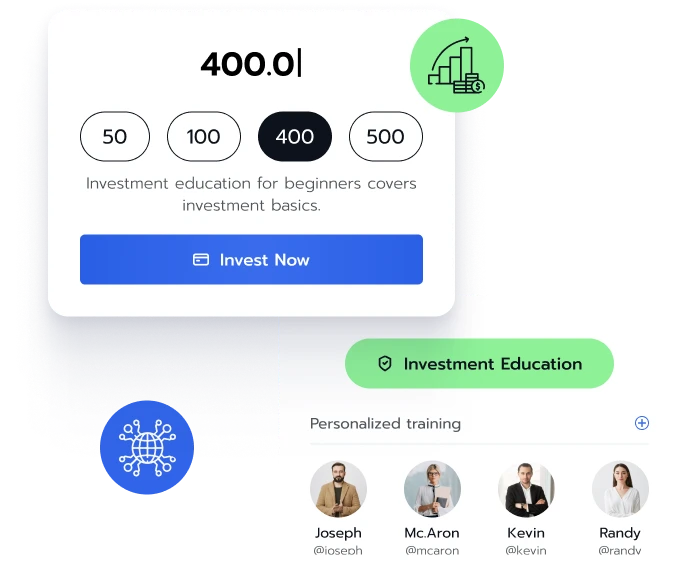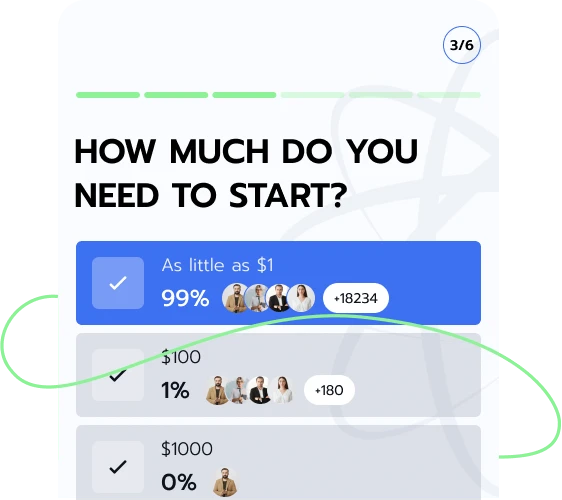
Immediate FastX helps people enhance their financial literacy by connecting them to investment education firms. The firms provide their students with the necessary investment, business, finance, and economic knowledge.
This learning process allows learners to see the bigger picture in the investment scene and make objective financial decisions. Everyone Immediate FastX connects can choose their areas of interest and build their knowledge.
To register on Immediate FastX, interested people should submit their names, emails, and phone numbers in the registration form. Once done, Immediate FastX will connect them right away with investment education firms. These firms will send their representatives to provide more information.
Irrespective of people’s line of business, career path, or profession, Immediate FastX believes that enrolling in investment training will give them a wider range of understanding. These include finance, money management, risk analysis and management, and taxation. To get additional knowledge, connect with investment education firms on Immediate FastX.
Investment education allows people to view issues differently and develop new ways to solve problems.
As people glean from their tutors, they also form suitable opinions on various issues. To get fresh perspectives through investment education, register on Immediate FastX.
People may become intellectually sound by signing up for investment education on Immediate FastX. They learn continuously, take quizzes, think critically, and strategize.
Also, they can query standing principles and theories and give constructive criticisms. Develop intellectual skills by registering on Immediate FastX.

By connecting with investment education firms, Immediate FastX helps people learn more about the economy and the factors or policies that lead to its growth (and decline). To learn more, register on Immediate FastX.
Through the investment education Immediate FastX provides with the help of investment teachers, people can discover ways to manage funds, save, budget, and pursue their financial goals. Learn to develop financial discipline by connecting with investment teachers on Immediate FastX.
Immediate FastX helps people understand the skills, expertise, and experiences needed to run businesses of any kind when matched with investment education firms. Register on Immediate FastX to get business knowledge from investment tutors.

Immediate FastX defines an investment education firm as an institution that teaches people investment concepts. The firm focuses on equipping people with the knowledge-based aspect of the course, not on making them investors. In other words, the firm only teaches people interested in acquiring investment knowledge for intellectual development.
A firm might run virtually, physically, or use the hybrid teaching model. Immediate FastX connects people with firms that run virtually to learn without distance barriers or huge costs. It also ensures that it connects people with firms offering investment courses in different languages. Begin investment learning by connecting with an investment education firm on Immediate FastX.
Investing is committing money to an asset, cause, company, or business with the possibility of appreciating and generating returns in the future. While an investment may yield gains, it also can generate losses due to different risks, which are often fully uncontrollable but only mitigable to an extent. Immediate FastX discusses types of risk analysis below:
Root cause analysis identifies and removes any problem-causing element in a business or company. It also evaluates the impact of an issue that happened or persists. To learn how this process is conducted. Register and connect with investment education firms on Immediate FastX.
The risk-benefit analysis compares an investment’s possible benefits and risks. Risk analysts rank benefits based on their projected impact or likelihood of success. Also, this analysis is done by comparing a company’s benefits to its financial and non-financial expenses (related to the benefits). To learn more, register on Immediate FastX.
Needs Assessment
Needs assessment analyzes a company’s current state.
Business Impact Analysis
Business impact analysis understands how a potential risk will affect a business.
Risk Identification
Risk identification involves listing potential risks a company or business may encounter.
The risks could be internal or external. To tackle the risks, members of a company or business should assemble to discuss probable ways to do so. The company can also use SWOT analysis to address the risks. To learn more, register on Immediate FastX.
This process involves identifying areas that can cause more trouble for a company. This could be an aspect that was unidentified as risky. After this, the company can estimate risk impact by checking how risks will affect a company financially. Other risk analysis processes include building an analysis model, analyzing results, and implementing solutions. To learn more, sign up on Immediate FastX.

KPIs measure a company’s or business’ performance against its targets, objectives, and competitors. KPIs require data collection, storage, cleaning, and synthesizing. The results from these processes allow a company to decide how effective existing systems are in achieving the business goals. Businesses also use KPIs to make strategic decisions.
Types of KPIs are leading/lagging, strategic, functional, and operational. Leading/lagging KPIs focus on whether the data being analyzed indicates whether an event will occur or has occurred. Strategic KPIs like company revenue and return on investment (ROI) show how a company performs and are often used by executives. Functional KPIs focus on specific departments within a company. A software development department might want to measure the number of downloads their application gets.
Operational KPIs measure a company’s performance daily or monthly by analyzing locations, segments, or processes. These KPIs are used by managing staff. Businesses often use KPIs such as IT, customer experience, sales, marketing, process performance, and financial metrics. Register on Immediate FastX and connect with investment teachers for detailed information about KPIs and these metrics.
Cash flow forecast projects a company’s inflow and outflow. It does not include potential bills or unpaid invoices. Forecasting cash flow relies on prior market research, judgment, or experience. Businesses conduct this forecast to know how to plan spending, when to invest, and when to manage when there is less income (to prevent the close of business). A cash flow forecast can be written in a spreadsheet or accounting software.
The forecast should contain a business’ inflow, cash flow, and net cash flow. The inflow to estimate includes tax refunds, loans, projected sales for goods and services, shareholder investments, loans, and sales of assets. The outflow to estimate are legal fees, travel expenses, vehicle costs, bank charges, rent, office equipment, tax payments, hospitality, salaries, insurance, utility bills, and monthly loan repayments. Immediate FastX highlights how to forecast cash flow below:
This involves estimating the inflow and outflow a business's operating activities may generate. These include cash received, interest accrued, dividends received, and money from product or service sales. Learn how to calculate or estimate cash flow from operating activities by connecting with investment tutors on Immediate FastX.
Estimating cash flow from financing activities involves estimating the inflow and outflow a company’s financing activities generate. These include investment losses/money lost from investment and investment gains/money received from investments like stocks and bonds. Register on Immediate FastX to learn how to estimate cash flow from financing activities.
This process involves estimating the inflow and outflow a company’s investing activities generate. They include cash outflows like equity interest, additional asset purchases, and possible returns from principal notes and equity sales. Want to learn more? Register on Immediate FastX.
Here, businesses add the values obtained from estimating cash flow from operating, financing, and investing activities. When forecasting cash flows, businesses should apply caution and be detailed. Sign up on Immediate FastX to learn more.
A brokerage facilitates loan acquisition, property sale, or asset purchase. This organization trades on the financial market, stores and protects customer data, lends to clients for margin transactions, and provides information about other market participants. Brokerages often specialize in credit, business, real estate, forex, stock, and leasing.
Types of brokers are full-service, discount, and online. Full-service brokers offer multiple services, which include equity research and investment advisory. A discount broker buys and sells orders at a commission rate, while an online broker offers services online. Sign up on Immediate FastX to learn more.
Underwriting is raising capital for an institution, government, or corporation from investors. Banks often execute this process. The phases of underwriting are planning, timing and demand, and issue structure. Banks plan by identifying the investment rationale and investors’ themes and understanding investors’ interest in this investment type.
Factors influencing the timing and demand of an investment offering are investors’ experience, current market condition, current news flow, precedents and benchmark offerings, and current investor appetite.
To decide the underwriting structure, banks check how an investment sale will occur, if to focus on institutional or retail investors, and if investors’ demands are located domestically or internationally. Learn more by registering on Immediate FastX.
Equity issuance fees refer to the cost of introducing securities into the market. This introduction is meant to expand its operation and develop its business. Some fees accrued during issuance are underwriting, marketing, clerical, and Securities and Exchange Commission (SEC) filing fees. Register on Immediate FastX to learn more.
A retainer fee is a fixed amount paid to an investment banker. Register on Immediate FastX and connect with investment tutors to learn more.
Success fee is the commission paid to an advisor for completing a transaction successfully. Want to know more? Register on Immediate FastX.
Clerical fee is paid to get the forms to fill and file when new securities are introduced. Learn more by registering on Immediate FastX.
This is the cost of promoting and advertising securities in the market. Register on Immediate FastX to get more details from investment education firms.
SEC filing fee is paid when filing security with the SEC on behalf of a company. To get more information about this, register on Immediate FastX.
A standby fee is the amount a borrower pays a lender to compensate them for lending. Sign up on Immediate FastX to know more.

Immediate FastX believes knowledge is critical to advancing one’s career, businesses, interpersonal relationships, and jobs. Without acquiring knowledge, widening one’s horizons, thinking critically, developing new perspectives, or solving problems will be impossible.
Investment education can help people achieve these and more. To get investment education, register on Immediate FastX to connect with investment education teachers.
| 🤖 Registration Cost | Free |
| 💰 Fees | No Fees |
| 📋 Registration | Simple, quick |
| 📊 Education Focus | Cryptocurrencies, Forex, Mutual Funds, and Other Investments |
| 🌎 Supported Countries | Most countries Except USA |


